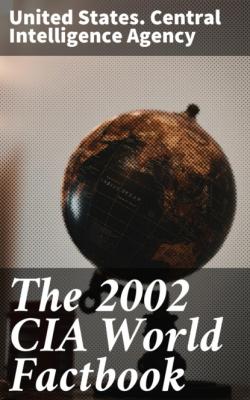ТОП просматриваемых книг сайта:
The 2002 CIA World Factbook. United States. Central Intelligence Agency
Читать онлайн.Название The 2002 CIA World Factbook
Год выпуска 0
isbn 4064066092382
Автор произведения United States. Central Intelligence Agency
Жанр Социология
Издательство Bookwire
Waterways: NA km
Pipelines: natural gas 900 km (1991)
Ports and harbors: none
Airports: 7 (2001)
Airports - with unpaved runways: total: 7 over 3,047 m: 1 1,524 to 2,437 m: 2 914 to 1,523 m: 3 under 914 m: 1 (2001)
Military Armenia
Military branches: Army, Air and Air Defense Forces, Border Guards
Military manpower - military age: 18 years of age (2002 est.)
Military manpower - availability: males age 15-49: 912,650 (2002 est.)
Military manpower - fit for military service: males age 15-49: 722,035 (2002 est.)
Military manpower - reaching military age annually: males: 34,998 (2002 est.)
Military expenditures - dollar figure: $135 million (FY01)
Military expenditures - percent of GDP: 6.5% (FY01)
Transnational Issues Armenia
Disputes - international: Armenia supports ethnic Armenian secessionists in Nagorno-Karabakh and militarily occupies almost one-fifth of Azerbaijan - Organization for Security and Cooperation in Europe (OSCE) continues to mediate dispute; border with Turkey remains closed over Nagorno-Karabakh dispute; traditional demands regarding former Armenian lands in Turkey have subsided
Illicit drugs: illicit cultivator of cannabis mostly for domestic consumption; increasingly used as a transshipment point for illicit drugs - mostly opium and hashish - to Western Europe and the US via Iran, Central Asia, and Russia
This page was last updated on 1 January 2002
========================================================================
Andorra
Introduction
Andorra
Background: Long isolated and impoverished, mountainous Andorra has achieved considerable prosperity since World War II through its tourist industry. Many immigrants (legal and illegal) are attracted to the thriving economy with its lack of income taxes.
Geography Andorra
Location: Southwestern Europe, between France and Spain
Geographic coordinates: 42 30 N, 1 30 E
Map references: Europe
Area: total: 468 sq km water: 0 sq km land: 468 sq km
Area - comparative: 2.5 times the size of Washington, DC
Land boundaries: total: 120.3 km border countries: France 56.6 km,
Spain 63.7 km
Coastline: 0 km (landlocked)
Maritime claims: none (landlocked)
Climate: temperate; snowy, cold winters and warm, dry summers
Terrain: rugged mountains dissected by narrow valleys
Elevation extremes: lowest point: Riu Runer 840 m highest point: Coma
Pedrosa 2,946 m
Natural resources: hydropower, mineral water, timber, iron ore, lead
Land use: arable land: 2% permanent crops: 0% other: 98% (1998 est.)
Irrigated land: NA sq km
Natural hazards: avalanches
Environment - current issues: deforestation; overgrazing of mountain meadows contributes to soil erosion; air pollution; wastewater treatment and solid waste disposal
Environment - international agreements: party to: Hazardous Wastes signed, but not ratified: none of the selected agreements
Geography - note: landlocked; straddles a number of important crossroads in the Pyrenees
People Andorra
Population: 68,403 (July 2002 est.)
Age structure: 0-14 years: 15.2% (male 5,456; female 4,951) 15-64 years: 71.9% (male 25,855; female 23,311) 65 years and over: 12.9% (male 4,425; female 4,405) (2002 est.)
Population growth rate: 1.11% (2002 est.)
Birth rate: 9.97 births/1,000 population (2002 est.)
Death rate: 5.57 deaths/1,000 population (2002 est.)
Net migration rate: 6.74 migrant(s)/1,000 population (2002 est.)
Sex ratio: at birth: 1.07 male(s)/female under 15 years: 1.1 male(s)/female 15-64 years: 1.11 male(s)/female 65 years and over: 1 male(s)/female total population: 1.09 male(s)/female (2002 est.)
Infant mortality rate: 4.07 deaths/1,000 live births (2002 est.)
Life expectancy at birth: 86.58 years (2002 est.) male: Total fertility rate: 1.26 children born/woman (2002 est.)
HIV/AIDS - adult prevalence rate: NA%
HIV/AIDS - people living with HIV/AIDS: NA
HIV/AIDS - deaths: NA
Nationality: noun: Andorran(s) adjective: Andorran
Ethnic groups: Spanish 43%, Andorran 33%, Portuguese 11%, French 7%, other 6% (1998)
Religions: Roman Catholic (predominant)
Languages: Catalan (official), French, Castilian
Literacy: definition: NA total population: 100% male: NA% female: NA%
Government Andorra
Country name: Principality of Andorra conventional short form: Government type: parliamentary democracy (since March 1993) that retains as its heads of state a coprincipality; the two princes are the president of France and bishop of Seo de Urgel, Spain, who are represented locally by coprinces' representatives
Capital: Andorra la Vella
Administrative divisions: 7 parishes (parroquies, singular - parroquia);
Andorra la Vella, Canillo, Encamp, La Massana, Escaldes-Engordany,
Ordino, Sant Julia de Loria
Independence: 1278 (was formed under the joint suzerainty of France and Spain)
National holiday: Our Lady of Meritxell Day, 8 September (1278)
Constitution: Andorra's first written constitution was drafted in 1991; approved by referendum 14 March 1993; came into force 4 May 1993
Legal system: based on French and Spanish civil codes; no judicial review of legislative acts; has not accepted compulsory ICJ jurisdiction
Suffrage: 18 years of age; universal
Executive branch: chief of state: French Coprince Jacques CHIRAC (since 17 May 1995), represented by Frederic de SAINT-SERNIN (since NA); Spanish Coprince Episcopal Monseigneur Joan MARTI Alanis (since 31 January 1971), represented by Nemesi MARQUES OSTE (since NA) elections: Executive Council president elected by the General Council and formally appointed by the coprinces for a four-year term; election last held 4 March 2001 (next to be held NA 2005) election results: Marc FORNE Molne elected executive council president; percent of General Council vote - NA% cabinet: Executive Council or Govern designated by the Executive Council president head of government: Executive Council President Marc FORNE Molne (since 21 December 1994)
Legislative branch: unicameral General Council of the Valleys or Consell General de las Valls (28 seats; members are elected by direct popular vote, 14 from a single national constituency and 14 to represent each of the 7 parishes; members serve four-year terms) elections: last held 4 March 2001 (next to be held NA March 2005) election results: percent of vote by party - PLA 46.1%, PSD 30%, PD 23.8%, other 0.1%; seats by party - PLA 15, PSD 6, PD 5, independents 2
Judicial branch: Tribunal of Judges or Tribunal de Batlles;

